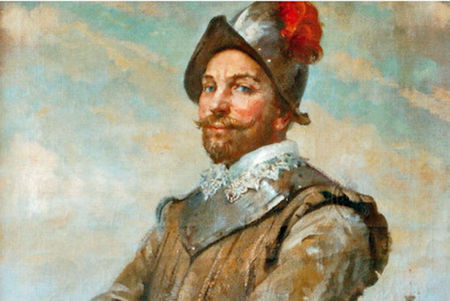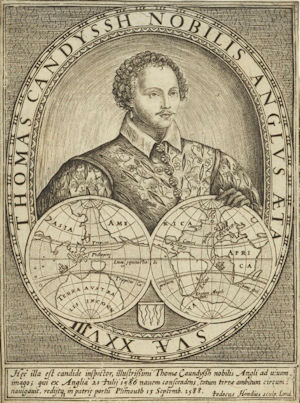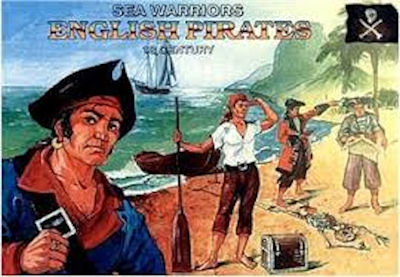 |  |
By Greg Niemann

Pirates, those sword-dueling adventurers of yore have long been romanticized in opera, novels and movies. The reality is that where there were riches in vulnerable ships, there were thieves lying in wait, and the grim brutality of the pirates was a matter of record.
To pirates, Baja California became important back in 1565 when Spanish galleons began rounding the cape as they crossed the Pacific to the Philippines and the Far East. Called “Manila Galleons,” these richly laden ships returned to Acapulco on their eventual journey to European ports.
Over 1,000 ships followed the same sea-road for a period of 250 years and the Spanish exchanged cochineal, cocoa, copper and other products for silk, ivory, articles of jasper and jade, urns, bronzes, chinaware, pearls, gold, rubies and diamonds from the Orient. Where such wealth was handled by sea, piracy was a real and common threat.
Over the years seamen from other nations often took on the Spanish ships. Sir Francis Drake was the first major English pirate to challenge the Spanish in their Pacific domain. In 1578, Drake and his three ships attacked ports all over the Pacific.
Their booty was so great that the little Golden Hind at only 120 tons had to limit its cargo to just silver and gold. Called the “Scourge of God” by his Spanish victims, Drake stopped at the southern tip of Baja to take on water and then proceeded north.
Emboldened by Drake’s success, English and Dutch pirates began attacking the Spanish ships. Their raids not only embarrassed the Spanish crown but also caused a serious financial drain on the country’s wealth. The Spaniards were often forced to hide out in Baja’s coves, bays and harbors, most notably those at La Paz and Cabo San Lucas.
Thomas Cavendish attacks the Santa Ana

Between 1586 and 1588 another English pirate, Thomas Cavendish, caused considerable damage to the Spanish fleet all along the Pacific Coast. Cavendish, who later claimed he burned 119 vessels, had committed every type of crime imaginable. But he never hit the jackpot in terms of gold or silver, that is until he decided to take on the 700-ton Spanish galleon Santa Ana at Cabo San Lucas in 1587. It was described by the Bishop of the Philippines as “the richest ship to ever leave these isles.”
Cavendish and his two small ships, the 120-ton Desire and 80-ton Content went to Cabo San Lucas to lay in wait.
According to English seaman Francis Petty, “On 14 November we fell with the cape of S. Lucas, which cape is very like the Needles at the Isles of Wight; and within the said cape is a great bay called by the Spaniards Aguada Segura (San Jose del Cabo).”
That day the Desire and Content spotted a sail. They gave chase and the smaller, faster English ships caught up to the larger vessel in about four hours.
“We gat up unto them…”
Petty continued,
“In the afternoone we gat up unto them, giving them the broad side with our great ordinance and a volee of small shot, and presently layed the ship aboord. ….it was called the S. Anna, & thought to be 700 tunnes. “Now as we were ready on their ships side to enter her, being not past 50 or 60 men at the uttermost in our ship, we perceived that the Captaine of the said ship had made fights fore and after… and having not one man to be seene, stood close under their fights, with lances, javelings, rapiers, and targets, & an innumerable sort of great stones, which they threw overboard upon our heads and into our ship so fast and there being so many of them, that they put us off the ship againe, with the losse of 2 of our men which were slaine, & with the hurting of 4 or 5…..”
Aboard the Santa Ana was seaman Antonio de Sierra. He reported,

“Those of us on our ship, the Santa Ana, as soon as we saw the said English on board with swords and iron bucklers, went at them and we killed five English and wounded six, leaving three of our men dead. The English general….then in full earnest began to ram us cruelly. During this encounter, an Englishman climbed into our rigging; and, since we did not see him, he was able to cut the mainsail retainers. Our Captain then loaded two balls in an arquabus and fired at the man on the mainmast. He killed him and the man fell dead on the upper deck of the ship….”
“A young man of little age”
The Santa Ana’s Captain Tomas de Alzola called Cavendish “An English corsair and thief…a young man of little age” (Cavendish was only 27 years old at the time). Captain de Alzola then described the continuing battle. “A third time the said English ship turned to come alongside the Santa Ana on the inside of the prow where Diego Melendez Flores was accompanied by the Captain and this squad of men. Although the enemy fired artillery and small arms, and boarded men over the fender-beam and side, they were resisted with great force and made to jump into the sea and onto their ship. Thus, they retired again, and standing off, they began to batter the said ship with their artillery.”
The galleon Santa Ana was a veritable fortress, but it was so heavily loaded that it could not maneuver and the cannons were below the water line rendering them useless. Sinking and without artillery, Captain de Alzola arranged for a surrender, sparing the lives of his remaining crew and passengers.
Captain de Alzola continued, “On the third day, the seventeenth of November, they went to the Port of San Lucas where they anchored with their ships and the ship Santa Ana. There, on the eighteenth, the General and officers of the aforesaid fleet gathered together, called all of the people of the said ship Santa Ana and ordered them that, under the threat of death, they should turn over all the keys to the boxes as well as deliver up all the gold they carried. In compliance with this, everyone brought forth the gold, perfume, musk and pearls which was a great deal and of great value. All of this was received by the said English General, and he put it away in a box. This entire day was spent at this task.”
Survivors put ashore

The following day, 190 survivors from the Santa Ana including four women and the future navigator Sebastian Vizcaino were put ashore. Cavendish had de Alzola remove the treasure of the ship as noted in the registry. Cavendish then piled all the gold and treasure and made three piles, keeping two for himself and letting his crew divide one pile.
Before leaving, the Englishmen took out all the chests and bundles and opened them with axes searching for more gold. Captain de Alzola reported, “In sacking the Santa Ana, they committed great harm and insolence until the twenty-ninth when they had no more space to load. In the manner of infidels and enemies of the Catholic Faith, they cut the masts and tackle of the said ship and then set fire to it.”
The survivors, including Vizcaino who was traveling as a merchant, extinguished the fire, repaired the Santa Ana as best they could, and they were able to sail it to the mainland.
The English pirates loaded the Desire and the Content with as much booty as they dare carry and set off. That very night they separated and the richly-laden Content was never heard from again. Cavendish, aboard the Desire, arrived in Plymouth, England in September 1588.
A dream of pirate treasure
The fate of the Content is a dream of pirate treasure that has endured through the ages. Could it be the same vessel referred to in an old Baja California Indian legend about a wooden ship found stranded in a bay with the dried-up corpses of men on board? When the Indians built a fire on the ship’s deck to cook their food, as they did on land, the ship burned and sank.
The riches of the Content, which allegedly had millions in silver pesos in addition to the plunder from the Santa Ana, have never been found. The Indian legend puts the vessel in a sheltered bay on the Pacific north of Cabo San Lucas. Over 400 years of storms and rising coastlines could have buried any protruding evidence.
While many have searched over the years, Baja has not yielded the incredible treasure.
About Greg
Greg Niemann, a long-time Baja writer, is the author of Baja Fever, Baja Legends, Palm Springs Legends, Las Vegas Legends, and Big Brown: The Untold Story of UPS. Visit www.gregniemann.com.

Was planning to go to Mexico, but unfortunately my bike broke down. Got very friendly and fast...

Easy to buy Mexico car insurance from and good service

so far so good, however I have read good things about them